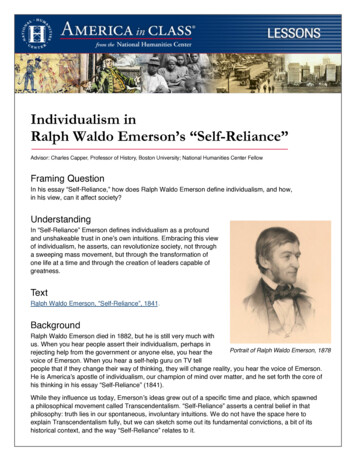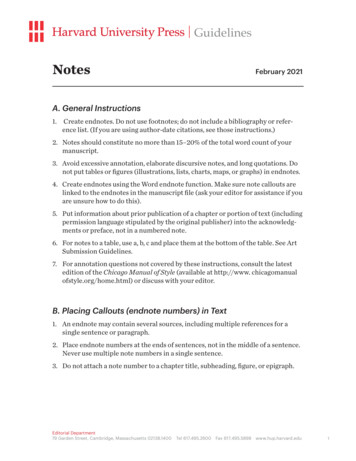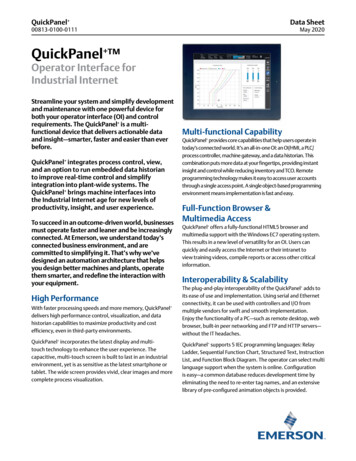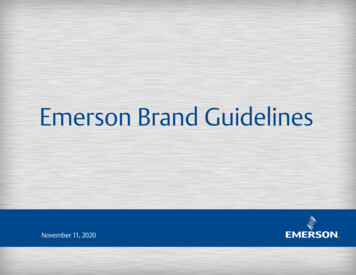
Transcription
Individualism inRalph Waldo Emerson’s “Self-Reliance”Advisor: Charles Capper, Professor of History, Boston University; National Humanities Center FellowFraming QuestionIn his essay “Self-Reliance,” how does Ralph Waldo Emerson define individualism, and how,in his view, can it affect society?UnderstandingIn “Self-Reliance” Emerson defines individualism as a profoundand unshakeable trust in one’s own intuitions. Embracing this viewof individualism, he asserts, can revolutionize society, not througha sweeping mass movement, but through the transformation ofone life at a time and through the creation of leaders capable ofgreatness.TextRalph Waldo Emerson, “Self-Reliance”, 1841.BackgroundRalph Waldo Emerson died in 1882, but he is still very much withus. When you hear people assert their individualism, perhaps inPortrait of Ralph Waldo Emerson, 1878rejecting help from the government or anyone else, you hear thevoice of Emerson. When you hear a self-help guru on TV tellpeople that if they change their way of thinking, they will change reality, you hear the voice of Emerson.He is America’s apostle of individualism, our champion of mind over matter, and he set forth the core ofhis thinking in his essay “Self-Reliance” (1841).While they influence us today, Emerson’s ideas grew out of a specific time and place, which spawneda philosophical movement called Transcendentalism. “Self-Reliance” asserts a central belief in thatphilosophy: truth lies in our spontaneous, involuntary intuitions. We do not have the space here toexplain Transcendentalism fully, but we can sketch some out its fundamental convictions, a bit of itshistorical context, and the way “Self-Reliance” relates to it.
By the 1830s many in New England, especially theyoung, felt that the religion they had inherited fromtheir Puritan ancestors had become cold and im‐personal. In their view it lacked emotion and failedto foster that sense of connectedness to the divinewhich they sought in religion. To them it seemedthat the church had taken its eyes off heaven andfixed them on the material world, which under theprobings, measurements, and observations of sci‐ence seemed less and less to offer assurance ofdivine presence in the world.Contextualizing Questions1.2.3.4.5.What kind of text are we dealing with?For what audience was it intended?For what purpose was it written?When was it written?What was going on at the time of itswriting that might have influenced itscomposition?Taking direction from ancient Greek philosophyand European thinking, a small group of NewEngland intellectuals embraced the idea that men and women did not need churches to connect withdivinity and that nature, far from being without spiritual meaning, was, in fact, a realm of symbols thatpointed to divine truths. According to these preachers and writers, we could connect with divinity andunderstand those symbols — that is to say, transcend or rise above the material world — simply byaccepting our own intuitions about God, nature, and experience. These insights, they argued, neededno external verification; the mere fact that they flashed across the mind proved they were true.To hold these beliefs required enormous self-confidence, of course, and this is where Emerson and“Self-Reliance” come into the picture. He contends that there is within each of us an “aboriginal Self,” afirst or ground-floor self beyond which there is no other. In “Self-Reliance” he defines it in mystical termsas the “deep force” through which we “share the life by which things exist.” It is “the fountain of action andthought,” the source of our spontaneous intuitions. This self defines not a particular, individual identitybut a universal, human identity. When our insights derive from it, they are valid not only for us but for allhumankind. Thus we can be assured that what is true in our private hearts is, as Emerson asserts, “truefor all men.”But how can we tell if our intuitions come from the “aboriginal Self” and are, therefore, true? We cannot.Emerson says we must have the self-trust to believe that they do and follow them as if they do. If, indeed,they are true, eventually everyone will accept them, and they will be “rendered back to us” as “the univer‐sal sense.”Until the rest of the world accepts our beliefs, however, we will be out of step; we will be nonconformists.Emerson tells us not to worry. The essence of self-reliance is resistance to conformity. Indeed, nonconformity is a sign of strength: “Whoso would be a man,” he writes, “must be a nonconformist.” In asense “Self-Reliance” can be seen as a pep talk designed to strengthen our resolve to stand up tosociety’s efforts to make us conform. “Nothing,” Emerson thunders, “is at last sacred but the integrity ofyour own mind.” This is individualism in the extreme.While “Self-Reliance” deals extensively with theological matters, we cannot overlook its political signifi‐cance. It appeared in 1841, just four years after President Andrew Jackson left office. In the election of1828 Jackson forged an alliance among the woodsmen and farmers of the western frontier and the labor‐ers of eastern cities. Emerson opposed the Jacksonians over specific policies, chiefly their defense ofslavery and their support for the expulsion of Indians from their territories. But he objected to them onbroader grounds as well. Many people like Emerson, who despite his noncomformist thought still heldmany of the political views of the old New England elite from which he sprang, feared that the rise ofthe Jacksonian electorate would turn American democracy into mob rule. In fact, at one point in “Self-Individualism in Ralph Waldo Emerson’s “Self-Reliance” – A Close Reading Guide from America in Class2
Reliance” he proclaims “now we are a mob.” When you see the word “mob” here, do not picture a large,threatening crowd. Instead, think of what we today would call mass society, a society whose culture andpolitics are shaped not by the tastes and opinions of a small, narrow elite but rather by those of a broad,diverse population. Emerson opposed mass-party politics because it was based on nothing more thannumbers and majority rule, and he was hostile to mass culture because it was based on manufacturedentertainments. Both, he believed, distracted people from the real questions of spiritual health and socialjustice. Like some critics today, he believed that mass society breedsintellectual mediocrity and conformity. He argued that it producessoft, weak men and women, more prone to whine and whimper thanto embrace great challenges. Emerson took as his mission the taskof lifting people out of the mass and turning them into robust, sturdyindividuals who could face life with confidence. While he held out thepossibility of such transcendence to all Americans, he knew that notall would respond. He assured those who did that they would achievegreatness and become “guides, redeemers, and benefactors” whosepersonal transformations and leadership would rescue democracy.Thus if “Self-Reliance” is a pep talk in support for nonconformists, itis also a manual on how to live for those who seek to be individualsin a mass society.Describing “Self-Reliance” as a pep talk and a manual re-enforcesthe way most people have read the essay, as a work of affirmationand uplift, and there is much that is affirmative and uplifting in it. Yeta careful reading also reveals a darker side to Emerson’s self-reliance. His uncompromising embraceof nonconformity and intellectual integrity can breed a chilly arrogance, a lack of compassion, and alonely isolation. That is why one critic has called Emerson’s work “deeply unconsoling.”1 In this lessonwe explore this side of Emerson along with his bracing optimism.A word about our presentation. Because readers can take “Self-Reliance” as an advice manual for livingand because Emerson was above all a teacher, we found it engaging to cast him not as Ralph WaldoEmerson, a nineteenth-century philosopher, but as Dr. Ralph, a twenty-first-century self-help guru. Inthe end we ask if you would embrace his approach to life and sign up for his tweets.1. Louis Menand, The Metaphysical Club (New York; Farrar, Straus, and Giroux, 2001) p. 18.Text AnalysisParagraph 1Activity: VocabularyLearn definitions by exploring[1] I read the other day some verses written byhow words are used in context.an eminent painter which were original and notconventional. [2] The soul always hears an admonition in such lines, let the subject be what it may. [3] The sentiment they instil is of more value than anythought they may contain. [4] To believe your own thought, to believe that what is true for you in your privateheart is true for all men, — that is genius. [5] Speak your latent conviction, and it shall be the universal sense;for the inmost in due time becomes the outmost, — and our first thought is rendered back to us by the trumpets of the Last Judgment. [6] Familiar as the voice of the mind is to each, the highest merit we ascribe toMoses, Plato, and Milton is, that they set at naught books and traditions, and spoke not what men but whatthey thought. [7] A man should learn to detect and watch that gleam of light which flashes across his mindIndividualism in Ralph Waldo Emerson’s “Self-Reliance” – A Close Reading Guide from America in Class3
from within, more than the lustre of the firmament of bards and sages. [8] Yet he dismisses without noticehis thought, because it is his. In every work of genius we recognize our own rejected thoughts: they comeback to us with a certain alienated majesty. [9] Great works of art have no more affecting lesson for us thanthis. [10] They teach us to abide by our spontaneous impression with good-humored inflexibility then most[especially] when the whole cry of voices is on the other side. [11] Else [otherwise], to-morrow a stranger willsay with masterly good sense precisely what we have thought and felt all the time, and we shall be forced totake with shame our own opinion from another.What is important about the verses written by the painter in sentence 1?From evidence in this paragraph, what do you think Emerson means by “original”?In sentences 2 and 3 how does Emerson suggest we should read an “original” work?In telling us how to read an original work, what do you think Emerson is telling us about reading his work?How does Emerson define genius?Considering this definition of genius, what does Emerson mean when he says that “the inmost in duetime becomes the outmost”?Individualism in Ralph Waldo Emerson’s “Self-Reliance” – A Close Reading Guide from America in Class4
Why, according to Emerson, do we value Moses, Plato, and Milton?Thus far Emerson has said that we should seek truth by looking into our own hearts and that we, likesuch great thinkers as Moses, Plato, and Milton, should ignore what we find in books and in the learningof the past. What implications does his advice hold for education?Why then should we bother to study “great works of art” or even “Self-Reliance” for that matter?Based on your reading of paragraph 1, how does Emerson define individualism? Support your answerwith reference to specific sentences.Paragraph 34 (excerpt)Activity: Dr. Ralph’s Tweets[1] The sinew and heart of man seem to be drawnDecipher Emerson’s aphorisms.out, and we are become timorous, desponding whimperers. [2] We are afraid of truth, afraid of fortune,afraid of death, and afraid of each other. [3] Our ageyields no great and perfect persons. [4] We want men and women who shall renovate life and our social state, but we seethat most natures are insolvent, cannot satisfy their own wants [needs], have an ambition out of all proportion to theirpractical force [aim at goals they cannot achieve], and do lean and beg day and night continually . [5] We are parloursoldiers. [6] We shun the rugged battle of fate, where strength is born.What, according to Emerson, is wrong with the “social state” of America in 1841?Individualism in Ralph Waldo Emerson’s “Self-Reliance” – A Close Reading Guide from America in Class5
Given the political context in which he wrote “Self-Reliance,” why might Emerson think that Americansociety was no longer capable of producing “great and perfect persons”?What is Emerson’s solution for America’s problem, and how does that solution illuminate what he is tryingto do in “Self-Reliance”?Paragraph 35 (excerpt)[1] If our young men miscarry in their first enterprises, they lose all heart. If the young merchant fails, mensay he is ruined. [2] If the finest genius studies at one of our colleges, and is not installed in an office withinone year afterwards in the cities or suburbs of Boston or New York, it seems to his friends and to himselfthat he is right in being disheartened, and in complaining the rest of his life. [3] A sturdy lad from NewHampshire or Vermont, who in turn tries all the professions, who teams it, farms it, peddles, keeps a school,preaches, edits a newspaper, goes to Congress, buys a township,* and so forth, in successive years, and always,like a cat, falls on his feet, is worth a hundred of these city dolls. [4] He walks abreast with his days, and feelsno shame in not ‘studying a profession,’ for he does not postpone his life, but lives already. He has not onechance, but a hundred chances.* Emerson does not mean that the “sturdy lad” would buy a town. He probably means that he would buy a large piece ofuninhabited land (townships in New England were six miles square). The point here is that he would become a substantiallandowner.What does Emerson mean by “miscarry”? What context clues help us discover that meaning?What is the relationship between the young men who miscarry and the young merchants who fail inparagraph 35 and the “timorous, desponding whimperers” of paragraph 34?Individualism in Ralph Waldo Emerson’s “Self-Reliance” – A Close Reading Guide from America in Class6
According to Emerson, how does an “un-self-reliant” person respond to failure?Emerson structures this paragraph as a comparison between a “city doll” and a “sturdy lad.”With reference to paragraph 34 what does the “sturdy lad” represent?What are the connotations of “city doll”?Compare a “city doll” with a “sturdy lad.”What point does Emerson make with this comparison?What do you notice about the progression of the jobs Emerson assigns to his “sturdy lad”?Individualism in Ralph Waldo Emerson’s “Self-Reliance” – A Close Reading Guide from America in Class7
We have seen that Emerson hopes to raise above the mob people who will themselves be “great andperfect persons” and restore America’s ability to produce such people. What does the progression ofjobs he assigns to the “sturdy lad” suggest about the roles these people will play in American society?Paragraph 36Activity: Living the Self-Reliant Life[1] It is easy to see that a greaterself-reliance must work a revoluExplore Emerson’s advice on how to livetion in all the offices and relationsthe self-reliant life.of men; in their religion; in theireducation; in their pursuits; theirmodes of living; their association; in their property; in their speculative views.Why does Emerson think that “a greater self-reliance must work a revolution in all the offices andrelations of men”?Individualism in Ralph Waldo Emerson’s “Self-Reliance” – A Close Reading Guide from America in Class8
Glossaryadmonition: gentle, friendly criticismlatent: hiddennaught: ignoredlustre: brightnessfirmament: skybards: poetssages: wise men and womenalienated: made unfamiliar by being separated from uselse: otherwisesinew: connective tissuestimorous: shyinsolvent: emptyPortrait of Ralph Waldo Emerson engraved and published by Stephen A. Schoff, Newtonville, Massachusetts, 1878, from anoriginal drawing by Samuel W. Rowse [ca. 1858] in the possession of Charles Eliot Norton. Courtesy of the Library of Congress,Prints & Photographs Division, LC-DIG-pga-04133.Daguerreotype of Ralph Waldo Emerson, 4 x 5 black-and-white negative, creator unknown. Courtesy of the Yale Collection ofAmerican Literature, Beinecke Rare Book and Manuscript Library, Yale University, New Haven, Connecticut.Individualism in Ralph Waldo Emerson’s “Self-Reliance” – A Close Reading Guide from America in Class9
back to us with a certain alienated majesty. [9] Great works of art have no more affecting lesson for us than this. [10] They teach us to abide by our spontaneous impression with good-humored inflexibility then most [especially] when the whole cry of voices is on the oth










